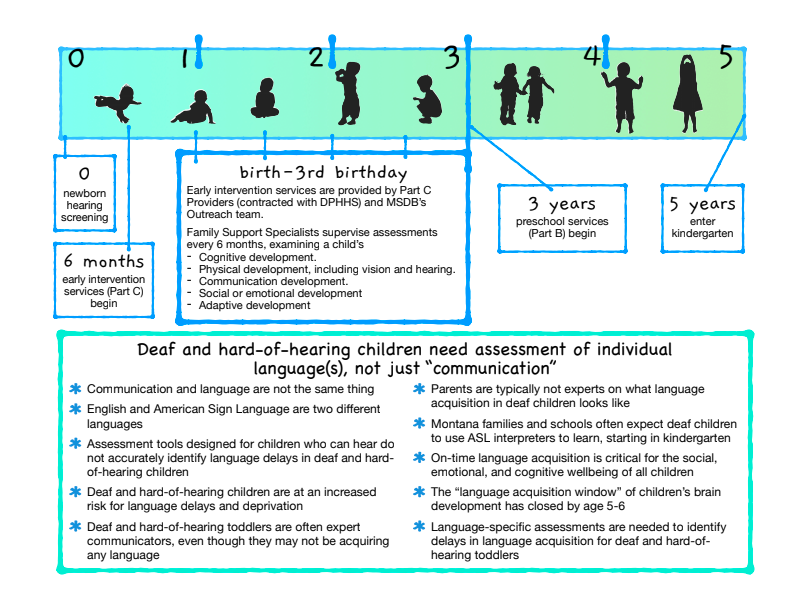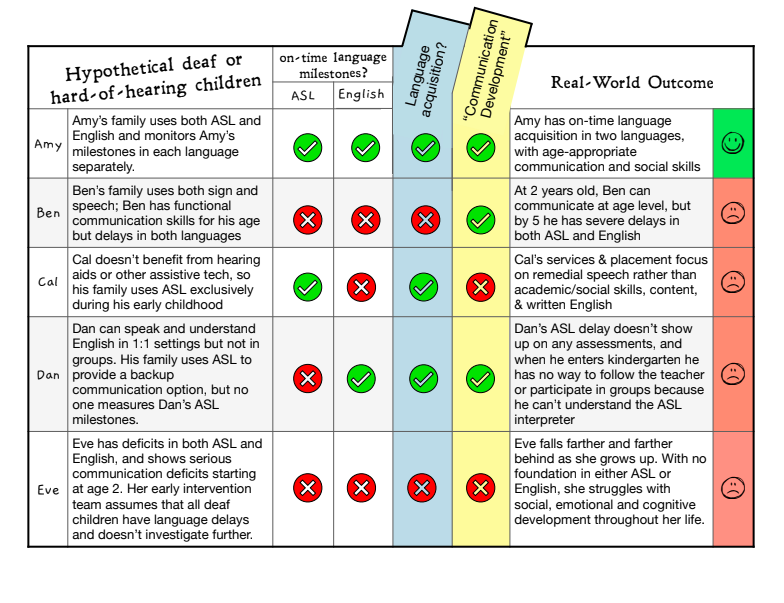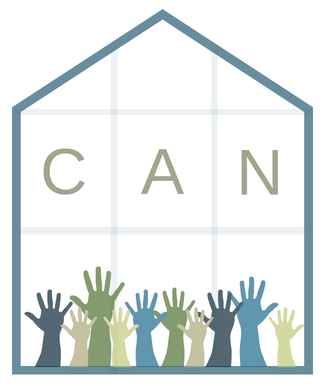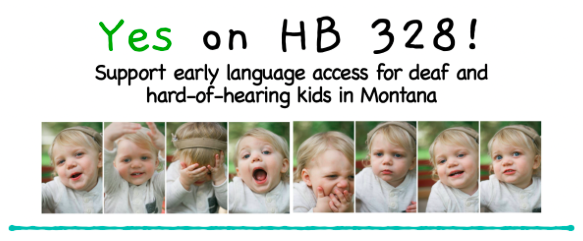Here is an update from the leaders of the Lead-K MT project…
Yes on HB 328 (Lead-K MT)
Questions? Want more information?
contact LeadKMontana@gmail.com
We made it out of the House!
Next step: Senate Committee Hearing.
We’ve been assigned to the Senate Public Health, Welfare and Safety committee. The committee hearing will be on
Monday, March 22, starting at 3:00 pm.
Keep an eye on the bill’s progress through the Montana Legislature’s website here.
The first few years of a child’s life are crucial for language development. If kids don’t get started on language acquisition early enough, it’s very hard to catch up later. Deaf babies and toddlers are at a high risk of language delays, so they need regular assessments to make sure they are on track for success.
This simple bill is an important step toward making sure that deaf and hard-of-hearing children in Montana get the early access to language that they need for success.
Bill Summary (short):
HB 328 asks the Department of Health and Human Services (DPHHS) to put together a list of tools that measure early language acquisition so that parents can identify language delays early, with plenty of time to address them, and to collect and publish data on language acquisition in deaf/hard of hearing infants and toddlers around the state.


You can help!
Contact the Senate Committee on Public Health, Welfare, and Safety and ask them to vote YES on HB328.
Committee Member Contact Information:
Phone, email, or send a web message here
Senate Committee on Public Health, Welfare, and Safety:
Name (party) | Senate District | phone | ||
David Howard (R) | (Chair) | SD 29 | David.Howard@mtleg.gov | (406) 633-2762 |
Carl Glimm (R) | (Vice Chair) | SD 2 | carl.glimm@mtleg.gov | (406) 751-7334 |
Jen Gross (D) | (Vice Chair) | SD 25 | Jen.Gross@mtleg.gov | 406) 696-0649 |
Steve Hinebauch (R) | SD 18 | steve.hinebauch@mtleg.gov | (406) 365-7967 | |
Bob Keenan (R) | SD 5 | Bob.Keenan@mtleg.gov | (406) 250-4111 | |
Tom McGillvray (R) | SD 23 | Tom.McGillvray@mtleg.gov | (406) 698-4428 | |
Mary McNally (D) | SD 24 | Mary.McNally@mtleg.gov | (406) 671-1376 | |
Brad Molnar (R) | SD 28 | brad.molnar@mtleg.gov | (406) 794-5982 | |
Diane Sands (D) | SD 49 | SenatorSands@gmail.com | (406) 251-2001 |
Bill Explanation and Summary :
Deaf and Hard-of-Hearing children are at a high risk for language delays and language deprivation. Often, they do not get enough language support when they are very young, and parents do not always notice the delays or realize how far behind they are until they are past the best developmental stage for language acquisition (this window typically closes around 3-5 years). Currently, young deaf/hh children who are getting early intervention services in Montana get regular assessments for their communication skills- but they don’t always get assessed for language skills specifically. Young children can be very good at communicating (using gestures and facial expressions, etc) without using any actual language- so an assessment of communication development that does not look at each language separately may not identify delays in a timely manner.
HB 328 asks the Department of Health and Human Services (DPHHS) to put together a list of assessment tools (checklists, etc) that measure English acquisition, and assessment tools that measure ASL acquisition, so that parents and early intervention providers (Part C Service Providers) can choose the right tools for each child and monitor their acquisition progress in either or both languages.
HB 328 also asks DPHHS to publish a yearly report of the data- how many deaf/hh children ages 0-3 are receiving services, how many have gotten language-specific assessments, and how many of them have age-appropriate language acquisition. This will ensure that parents and early intervention providers are aware of any language delays, and can provide the necessary help so that the children get caught up. It also makes sure that Montana’s early intervention system is aware of the overall quality of services that are being provided.
Read the full text of the bill here
(leg.mt.gov/bills/2021/billpdf/HB0328.pdf)
Reference list for MT HB 328
Goberis, D., Beams, D., Dalpes, M., Abrisch, A., Baca, R., and Yoshinaga-Itano, C. (2012). The missing link in language development of deaf and hard of hearing children: Pragmatic language development. Seminars in Speech and Language. 33(4): 297-309.
Hall, M. L., Eigsti, I-M., Bortfeld, H., & Lillo-Martin, D. (2016). Auditory deprivation does not impair executive function, but language deprivation might: Evidence form a parent-report measure in deaf native signing children. Journal of Deaf Studies and Deaf Education, 22(11).
Hatrak, M. & Petersen, L.T. (2017). The Road to Kindergarten Readiness: Language Policy for Deaf Children Ages 0-5. Sacramento, CA: CAD Publications.
Humphries, T., Kushalnagar, P., Mathur, G., Napoli, D. J., Padden, C., Rathmann, C., & Smith, S.R. (2013). The right to language. Law, Medicine, Ethics.
Karchmer, M. A., and Mitchell, R.E. (2003). Demographic and achievement characteristics of deaf and hard of hearing students. In M. Marschark & P.E. Spencer (Eds.) Oxford handbook of Deaf Studies, Language and Education. New York: Oxford University Press. 21-37.
Kuhl, P. (2004). Early language acquisition: Cracking the speech code. Nature, 5, 831-843.
Kuntze, M. (1998). Literacy and deaf children: The language question. Topics in Language Disorders, 18(4), 1-15.
Kushnalnagar, P., Mathur, G., Moreland, C. J., Napoli, D. J., Osterling, W., Padden, C., Rathmann, C. (2010) Infants and children with hearing loss need early language access. Journal of Clinical Ethics, 21(2), p. 143-154.
Lust, B. (2006). Child language acquisition and growth. Cambridge, United Kingdom: Cambridge University Press.
Mayberry, R.I., Chen, J.K., Witcher, P., & Klein, D. (2011). Age of acquisition effects on the functional organization of language in the adult brain. Brain and Language, 119, 16-29.
Meadow, K. (1980). Deafness and Child Development. Berkeley, CA: University of California
Penicaud, S., Klein, D., Zatorre, R.J., Chen, J.K., Witcher, P., Hyde, K., & Mayberry, R.I. (2012). Structural brain changes linked to delayed first language acquisition in congenitally deaf individuals. NeuroImage, 66, 42-49.
Scott, J. A. & Hoffmeister, R. J. (2016). American Sign Language and academic English: Factors influencing the reading of bilingual secondary school deaf and hard of hearing students. Journal of Deaf Studies and Deaf Education, 00, p. 1-13.
Snoddon, K. (2008). American sign language and early intervention. The Canadian Modern Langauge Review, 64(4), 581-604.
Supalla, S. J. & Cripps, J. H. (2008). Linguistic accessibility and deaf children. In B. Spolsky & F. M. Hult (Eds.), The handbook of educational linguistics (pp.174-191). Oxford, UK: Oxford University Press.

